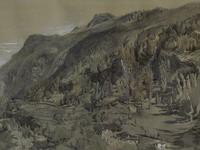John Ruskin and the Geographical Imagination
Denis Cosgrove selects works from Ruskin’s Teaching Collection and reveals a poetry of landscape that inspired geographical learning a century ago.

Introduction
John Ruskin died in 1900. The same year saw the first Oxford students receive their diplomas for study in the newly established university discipline of Geography. The examination they sat for at the School of Geography at Oxford included questions about the influence of the Alps and Rhine on the course of human history, and of geological faults on the development of surface landforms. Reading the paper, a student who had attended Ruskin’s lectures on landscape or drawing classes at Oxford in the 1870s or 1880s might be forgiven for sensing the echoes of his own teacher in this 'new' Geography.
This article discusses a selection of the images Ruskin used to teach drawing 'so that my pupils may learn to love Nature'. It indicates that geographical teachers such as Halford Mackinder and Andrew John Herbertson shared something of Ruskin’s 'geographical imagination': a common spirit of enquiry into landscape as the visible expression of changing relations between human societies and the natural world.
Ruskin also shared with the geographers a faith in certain pedagogical techniques intended to deepen their students’ geographical imagination, notably field observation, sketching and drawing, and map study. Consistent with his claim that a student’s skill in drawing was less significant than the faithful observation and understanding of nature, Ruskin selected and presented visual images in lectures and drawing classes to illustrate good and bad practice in 'the thoughtful and passionate representation of the physical conditions appointed for human existence.' Many of them are his own work, using different styles and produced over more than five decades of travel across Europe: from upland Britain, through the Rhône and Rhine valleys to the Swiss Alps and beyond to the cities of Italy: Venice, Verona, Florence and Rome. For Ruskin, these regions represented the wonderful variety of the physical world and evidence of diverse cultural adjustments to topographic and climatic difference.
In teaching the moralities of landscape, Ruskin used the fragment and the photograph, the map and the cheap print, as well as the finished sketch, drawing and painting. But his greatest talents were verbal and literary: his capacity, for example, to paint the richest word descriptions of landscapes and places. Mackinder and Herbertson too, while working primarily through verbal description and synthesis, stressed the value of physical presence in the landscape, through field excursions, sketching and map-making. Ruskin’s images can be enjoyed for their aesthetic qualities alone; as educational tools they reveal a poetry of landscape that also inspired geographical learning a century ago.
This article is based on an exhibition devised and selected by Denis Cosgrove, Alexander von Humboldt Professor of Geography at the University of California Los Angeles, with assistance from Isla Cosgrove, and organised by the Ashmolean Museum in collaboration with the Ruskin School of Drawing and Fine Art and with the support of the Calouste Gulbenkian Foundation and Southern Arts. The exhibition set a selection of the images Ruskin used to teach drawing alongside various materials from the Oxford School of Geography’s early years.
John Ruskin and the Geographical Imagination was part of the programme of events to mark the centenary of the death of John Ruskin in 2000.
References
All references to Ruskin's writings are taken from The Works of Ruskin, Library Edition, 39 volumes, edited by E.T. Cook and Alexander Wedderburn, George Allen, London, 1903-1912 and given by volume number and page.




